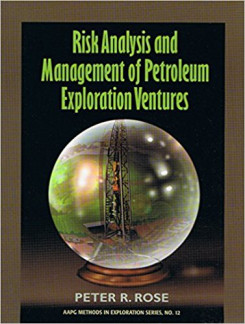Risk Analysis and Management of Petroleum Exploration Ventures
During the 1990s, many international petroleum companies improved their exploration performance significantly by using principles of risk analysis and portfolio management, in combination with new geotechnologies. While exploration risk cannot be eliminated, it can certainly be reduced substantially, on a portfolio scale.
And the widespread adoption of standardized risk analysis methods during the 1990s brought badly needed discipline to petroleum exploration. By the mid-1980s, most well-informed major international petroleum firms that were engaged in exploration recognized that, globally, the average size of new discoveries was diminishing. Not coincidentally, the class of exploratory prospects categorized as ''high risk/high-potential'' was showing marked signs of underperformance. For major companies, when all such ventures-which averaged around a 10% perceived probability of success-were considered, less than 1% actually discovered profitable oil and gas reserves, and the sizes of these discoveries were generally far smaller than predicted. All in all, such exploration for new giant fields destroyed value, rather than creating it, in the 1980s and early 1990s.
Consequently, exploration, as a corporate function, lost credibility. It badly needed to begin delivering on its corporate promises. It needed to become more efficient, and thereby more profitable. To optimize the allocation of exploration capital, concepts of portfolio management began to be considered.
Cast & Characters
| 1-4 | Introduction |
| 5-16 | Geotechnical Estimates under Uncertainty |
| 17-48 | Risk Analysis of Exploration Prospects |
| 49-56 | Economic Analysis of Exploration Ventures |
| 57-90 | Exploration Plays-Risk Analysis and Economic Assessment |
| 91-116 | Management of Exploration Projects as Business Ventures |
| 117-124 | Petroleum Industry Practices of Exploration Risk Analysis |
| 125-126 | Appendix A: Methods for Calculating the Mean of a Lognormal Distribution |
| 127-130 | Appendix B: Graphical Method for Combining Probabilistic Distributions by Multiplication |
| 131-136 | Appendix C: A Recurring Problem in Estimating Prospect Reserves, Determining Reasonable “Low-side" Values (P99% and P90%) |
| 137-146 | Appendix D: Evaluating and Combining Multiple-objective Ventures |
| 147-148 | Appendix E: Steps in Geotechnical Procedure for Prioritizing Petroleum Prospectivity in New Exploration Areas |
| 149-152 | Appendix F: Reconstructing Parent Field-size Distributions from Offshore FSDs |
| 153-154 | Appendix G: Matrix for Comparing, Ranking, and Planning New Exploration Plays |

